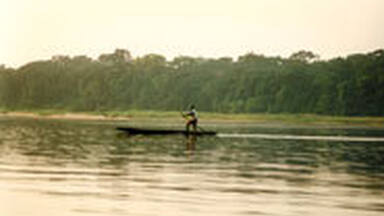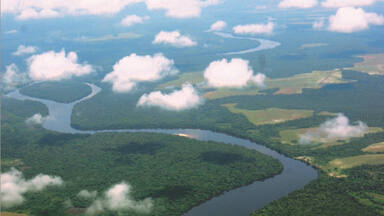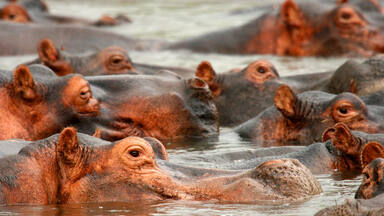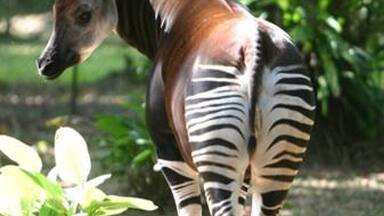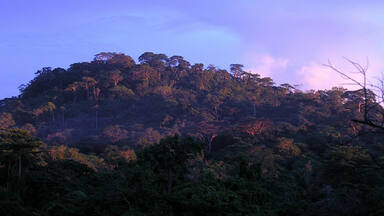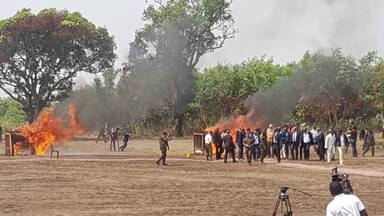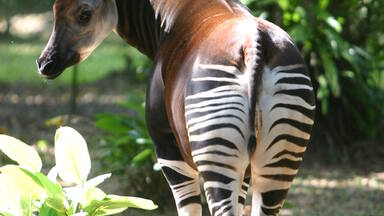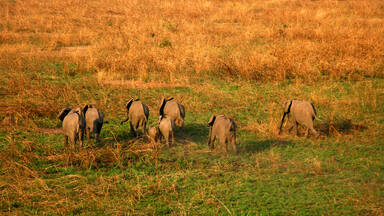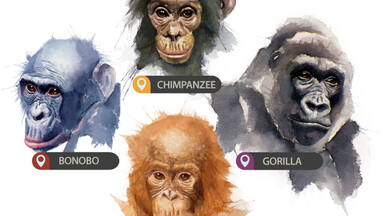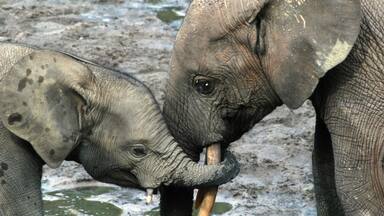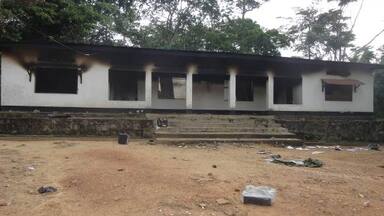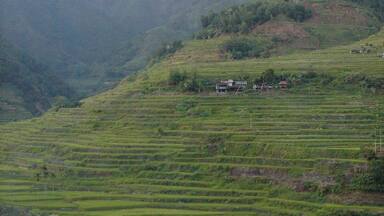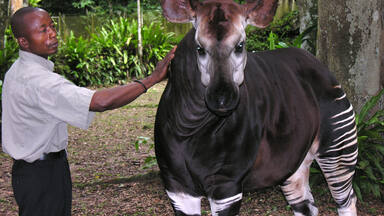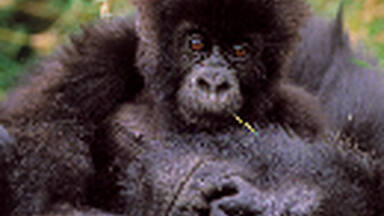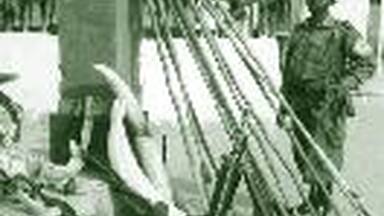Okapi Wildlife Reserve
Okapi Wildlife Reserve
The Okapi Wildlife Reserve occupies about one-fifth of the Ituri forest in the north-east of the Democratic Republic of the Congo. The Congo river basin, of which the reserve and forest are a part, is one of the largest drainage systems in Africa. The reserve contains threatened species of primates and birds and about 5,000 of the estimated 30,000 okapi surviving in the wild. It also has some dramatic scenery, including waterfalls on the Ituri and Epulu rivers. The reserve is inhabited by traditional nomadic pygmy Mbuti and Efe hunters.
Description is available under license CC-BY-SA IGO 3.0
Réserve de faune à okapis
La réserve de faune à okapis occupe environ un cinquième de la forêt d'Ituri au nord-est du pays. Le bassin du fleuve Congo, dont la réserve et la forêt font partie, est un des plus grands systèmes de drainage d'Afrique. La réserve de faune abrite des espèces menacées de primates et d'oiseaux et environ 5000 okapis, sur les 30 000 vivant à l'état sauvage. La réserve possède également des sites panoramiques exceptionnels, dont des chutes sur l'Ituri et l'Epulu. Elle est habitée par des populations nomades traditionnelles de Pygmées Mbuti et de chasseurs Efe.
Description is available under license CC-BY-SA IGO 3.0
محمية حيوانات الأوكابي
تحتل محمية حيوانات الأوكابي ما يقارب خمس غابة إيتوري شمال شرق البلاد. ويعتبر حوض نهر الكونغو الذي تشكل المحمية والغابة جزءاً منه أحد أكبر أنظمة تصريف المياه في افريقيا. وتحوي محمية الحيوانات اصنافاً مهددة من الرئيسات والطيور ونحو 5000 أوكابي من أصل 30000 أوكابي تعيش في البراري. كما تتضمن شلالات متساقطة على ايتوري وأيبولو وتحتضن شعوباً رحّلاً تقليدية من أقزام مبوتي وصيادي إيف.
source: UNESCO/CPE
Description is available under license CC-BY-SA IGO 3.0
俄卡皮鹿野生动物保护地
俄卡皮鹿野生动物保护地占据了位于刚果共和国东北部的伊图里(Ituri)森林五分之一的面积。保护区及其森林属扎伊尔河流域的一部分,而这个流域是非洲最大的排水系统之一。保护区内生存着许多濒危的灵长目类和鸟类动物。目前幸存的野生俄卡皮鹿有30 000头,其中5 000头栖息在这个保护区。区内也有其他壮丽景观,包括伊图里河(Ituri River)和埃普卢河(Epulu River)上的瀑布。这里居住着传统小矮人游牧民族——穆布提族(Mbuti)和埃费族(Efe)的猎人。
source: UNESCO/CPE
Description is available under license CC-BY-SA IGO 3.0
Фаунистический резерват Окапи
Фаунистический резерват Окапи занимает примерно одну пятую часть леса Итури на северо-востоке страны. Бассейн реки Конго, на территории которого расположен резерват и обширные леса, является самой крупной речной системой Африки. Резерват населяют птицы и приматы, находящиеся на грани исчезновения. Кроме того здесь обитает около 5000 из живущих на воле в Африке 30000 особей окапи. Здесь же располагаются потрясающие природные красоты, такие как водопады на реках Итури и Эпулу. На территории резервата проживают исконные кочевые охотники пигмейских племен Мбути и Эфе.
source: UNESCO/CPE
Description is available under license CC-BY-SA IGO 3.0
Reserva de fauna de Okapis
Situada al nordeste del país, esta reserva abarca la quinta parte del bosque de Ituri, que crece en la cuenca del río Congo, uno de los sistemas de drenaje más importantes del continente africano. Alberga especies de primates y aves en peligro de extinción, así como 5.000 de los 30.000 okapis que viven en estado salvaje. Asimismo, cuenta con parajes de excepcional belleza panorámica como las cataratas de los ríos Ituri y Epulu. La reserva está habitada por dos pueblos pigmeos nómadas: los mbuti y los cazadores efe.
source: UNESCO/CPE
Description is available under license CC-BY-SA IGO 3.0
オカピ野生生物保護区
source: NFUAJ
Wildreservaat Okapi
Source: unesco.nl
Outstanding Universal Value
Brief synthesis
Okapi Wildlife Reserve contains flora of outstanding diversity and provides refuge to numerous endemic and threatened species, including one-sixth of the existing Okapi population. The Reserve protects one-fifth of the Ituri forest, a Pleistocene refuge dominated by dense evergreen « Mbau » and humid semi-evergreen forests, combined with swamp forests that grow alongside the waterways, and clearings called locally « edos » and inselbergs.
Criterion (x): With its bio-geographical location, wealth of biotopes and the presence of numerous species that are rare or absent in the adjacent low altitude forests, it is probable that the Ituri forest served, during earlier drier climatic periods, as refuge for the tropical rainforest. To the north of the Reserve, the granite rocky outcrops, provide refuge to a plant species particularly adapted to this microclimate, characterised by numerous endemic species such as the Giant Cycad (Encepholarcus ituriensis).
The Reserve contains 101 mammal species and 376 species of documented birds. The population of the endemic species of Okapi (Okapia johnstoni), a forest giraffe, is estimated at 5,000 individuals. Among the endemic mammals of the forest in the north-east of the DRC identified in the Reserve, are the aquatic genet (Osbornictis piscivora) and the giant genet (Genetta victoriae). The Reserve provides refuge to 17 species of primates (including 13 diurnal and 4 nocturnal), the highest number for an African forest, including 7,500 chimpanzees (Pan troglodytes).
The Reserve also contains one of the most diverse populations of forest ongulates with 14 species, including six types of cephalophus. It also provides refuge to the largest population of forest elephants ((Loxodonta africana cyclotis) still present in eastern DRC, estimated at 7,500 individuals, and it is important for the conservation of other forest species such as the bongo (Tragelaphus eurycerus), the dwarf antelope (Neotragus batesi), the water chevratain (Hyemoschus aquaticus), the forest buffalo (Syncerus caffer nanus) and the giant forest hog (Hylochoerus meinertzhageni). It is also documented as one of the most important protected areas in Africa for the conservation of birds, with the presence of numerous emblematic species such as the Congo Peafowl (Afropavo congensis), as well as numerous endemic species in eastern DRC.
Integrity
The forests of the Reserve are among the best preserved in the Congo Basin and its area is considered sufficient to maintain its wildlife. The Reserve is part of a larger forestry area, that of Ituri, which remains almost untouched by logging and agricultural activities.
Protection and management requirements
The property is protected under a Wildlife Reserve statute. The Reserve contains a large indigenous population, the Mbuti and Efe pygmies, and the forest ecosystem is essential for both their economic and cultural requirements. A management plan covering three management areas in the Reserve has been proposed.
This includes a fully protected core zone of 282,000 ha comprising 20% of the Reserve where all hunting is prohibited, and an area of 950,000 ha for traditional use, where self-regulated hunting; using traditional methods; is authorized to cover the basic needs of the human population of the Reserve in forest products. Permanent installations and agricultural clearing are authorized in the 18,000 ha development area that comprises a narrow band on each side of the No. 4 national road crossing through the central part of the Reserve, and along a secondary road that links Mambasa to Mungbere, at the eastern border of the property. There are plans to make the whole protected area a national park. A buffer zone of 50 km wide has been defined around the entire Reserve.
The primary management challenges facing this Reserve are immigration control in the development area, prohibition of agricultural encroachment within the 10 km wide strip located along the road, and ensuring of the involvement of the indigenous populations, Mbuti and Efe pygmies, in the management of the Reserve. Another key challenge concerns the control of commercial poaching and artisanal mining. While the Reserve benefits from support from various NGOs and additional funding, it is imperative to obtain human and logistical resources to ensure the effective management of the property and its buffer zone.

